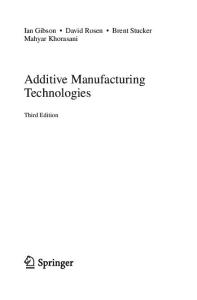Additive Manufacturing and size-dependent mechanical properties of three-dimensional microarchitected, high-temperature
- PDF / 665,530 Bytes
- 12 Pages / 584.957 x 782.986 pts Page_size
- 39 Downloads / 898 Views
Ryan Hensleigh Macromolecules Innovation Institute, Virginia Tech, Blacksburg, Virginia 24061, USA
Hongshun Chen Department of Mechanical Engineering, Virginia Tech, Blacksburg, Virginia 24061, USA
Xiaoyu Zhenga) Department of Mechanical Engineering, Virginia Tech, Blacksburg, Virginia 24061, USA; and Macromolecules Innovation Institute, Virginia Tech, Blacksburg, Virginia 24061, USA (Received 2 October 2017; accepted 14 December 2017)
3D microarchitected metamaterials exhibit unique, desirable properties influenced by their small length scales and architected layout, unachievable by their solid counterparts and random cellular configurations. However, few of them can be used in high-temperature applications, which could benefit significantly from their ultra-lightweight, ultrastiff properties. Existing high-temperature ceramic materials are often heavy and difficult to process into complex, microscale features. Inspired by this limitation, we fabricated polymer-derived ceramic metamaterials with controlled solid strut size varying from 10-lm scale to a few millimeters with relative densities ranging from as low as 1 to 22%. We found that these high-temperature architected ceramics of identical 3D topologies exhibit size-dependent strength influenced by both strut diameter and strut length. Weibull theory is utilized to map this dependency with varying single strut volumes. These observations demonstrate the structural benefits of increasing feature resolution in additive manufacturing of ceramic materials. Through capitalizing upon the reduction of unit strut volumes within the architecture, high-temperature ceramics could achieve high specific strength with only fraction of the weight of their solid counterparts.
I. INTRODUCTION
Engineering ceramics offer several beneficial properties, including high strength, wear resistance, high-temperature stability, and lightweight, compared to metals. These properties are desirable for many applications, including aerospace components such as gas turbine engines,1–5 as catalyst support,6 bioceramic scaffolds for tissue engineering,7,8 as temperature-resistant electronics, microelectromechanical systems,9–13 etc. In spite of these desirable properties, bulk ceramics have limited applications due to their high flaw sensitivity, bulky weight, and catastrophic fracture behavior upon loading, attributed to the persistence of distributed flaws within the ceramics: cracks, voids, and inclusions,14–16 which leads to a reduction in the fracture strength. Forming ceramics into highly complex shapes and interconnected porosities with high precision is, therefore, nearly impossible when a)
Address all correspondence to this author. e-mail: [email protected] DOI: 10.1557/jmr.2018.11
using traditional ceramic manufacturing and processing technologies. Only a few fabrication approaches for accessing miniaturized ceramic features have been reported, which typically rely on additive manufacturing (AM) of ceramic particles in polymer resin followed by sintering or nanoscale coatings on top of a
Data Loading...











